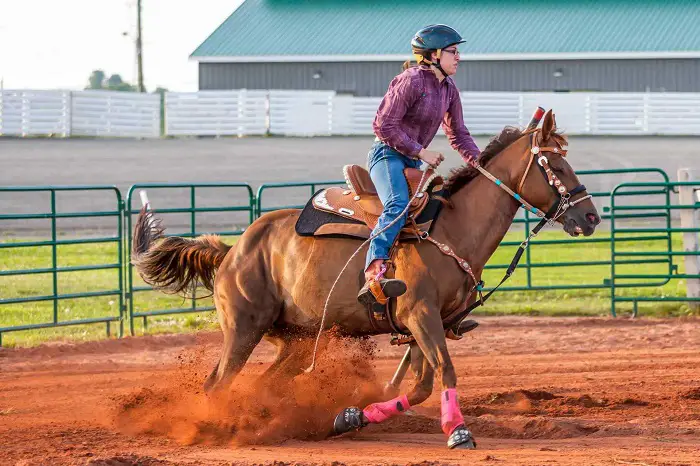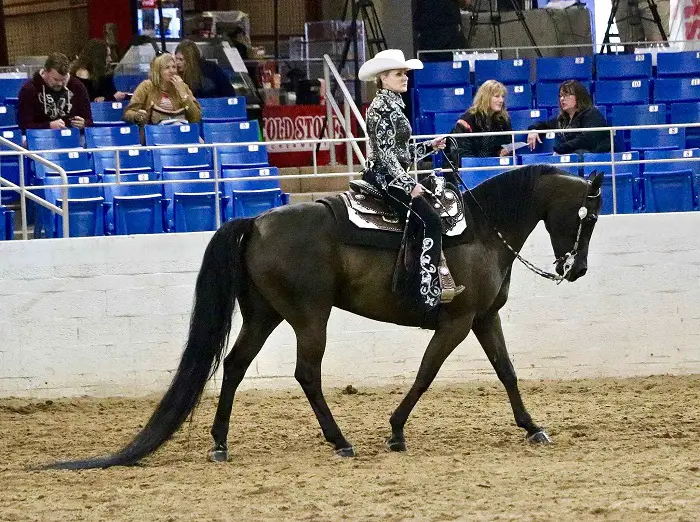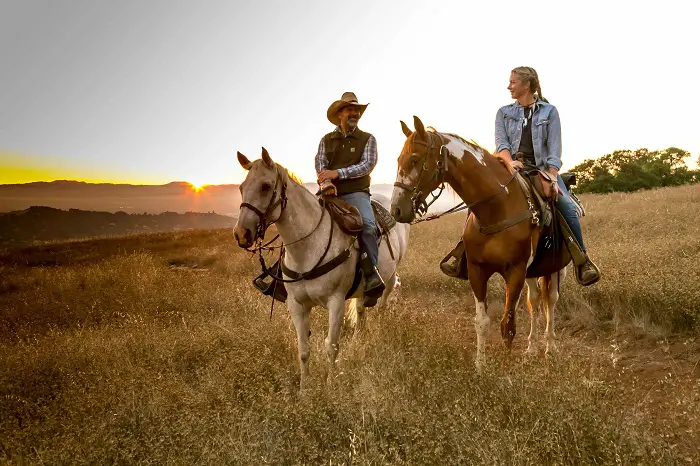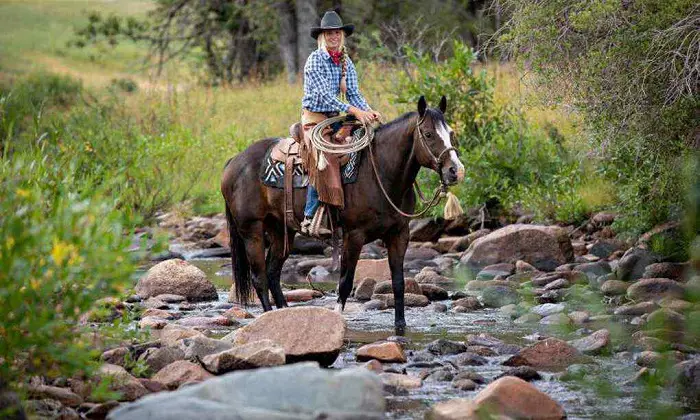Western horse riding, also known as Western riding, refers to the style of horseback riding and associated traditions that originated in the American West. It has evolved from the working practices of cowboys and ranchers in the 19th century and is closely associated with the culture of the American frontier. Western riding encompasses various activities, from everyday ranch work to rodeo events and recreational riding.
What are the Basics of Western Equestrian Sports?
Western riding is a distinctive equestrian style with its basics, including riding techniques, equipment, and a focus on horsemanship. Here are some of the basics of Western riding:
- Western Saddle: Western riding begins with a Western saddle, characterized by its larger size and a horn at the front. The saddle provides a comfortable and secure seat for the rider during long hours of riding.
- Bridle and Bit: Western riders use a Western-style bridle and bit. The harness is typically less complex than English harnesses, and the bit may vary depending on the horse’s needs and the rider’s preferences.
- Riding Attire: Western riders wear attire associated with cowboy culture, which often includes cowboy boots, jeans, a long-sleeved shirt, a wide-brimmed hat, and sometimes chaps or chinks for protection.
- Reins and Hand Position: Western riders often use one hand to hold the reins. The reins are typically kept loose, and riders use neck reining techniques, where they apply pressure on the horse’s neck to guide it instead of direct rein contact.
- Seat and Position: Riders sit deep in the saddle with a relaxed, upright posture. The legs are positioned slightly forward, and the rider’s weight is distributed evenly in the saddle. This position provides balance and stability.
- Communication: Western riding emphasizes clear and gentle communication with the horse. Riders use subtle cues and body movements to guide the horse. Riders also develop a strong partnership with their horse and aim to build trust and cooperation.
- Horsemanship: Understanding the horse’s behavior, needs, and body language is essential in Western riding. Horsemanship includes skills such as groundwork, grooming, and overall care for the horse.
- Safety: Safety is paramount in Western riding. Riders should wear appropriate safety gear, including a helmet, and be mindful of the safety of their horses.
- Respect for Tradition: Western riding has a rich history and tradition, often tied to cowboy culture and the American West. Riders should respect and preserve these traditions.
These basics of Western riding provide a foundation for those interested in this riding style, whether for recreational riding or participation in Western riding events and competitions. Riders must receive proper training and guidance from experienced Western riding instructors to develop their skills and horsemanship.
What’s the Difference Between Western and English Riding?
Western and English riding are two distinct styles of equestrian riding with different equipment, riding techniques, attire, and traditions. Here are some key differences between Western and English riding:
- Saddle:
- Western riders use a Western saddle, which is more significant, heavier, and designed for comfort during long hours in the saddle. It has a deep seat, a high cantle for stability, and often a horn at the front.
- English riders use a smaller and lighter English saddle. The saddle has a flatter seat, no horn, and is designed for close contact between the rider’s seat and the horse’s back.
- Bridle and Bit:
- Western riders use a Western-style bridle and bit. They often use one hand to hold the reins and may employ neck reining, where the horse responds to cues on the neck.
- English riders use an English harness and a variety of bits. They typically hold the reins with both hands and use direct rein contact for communication with the horse.
- Reins and Contact:
- Western riders often have a loose rein, and the contact with the horse’s mouth is typically lighter than in English riding.
- English riders maintain contact with the horse’s mouth through both reins, allowing for more precise control.
- Riding Attire:
- Western riders wear attire associated with cowboy culture, including cowboy boots, jeans, a wide-brimmed hat, and chaps or chinks for protection.
- English riders wear breeches, tall boots or jodhpur boots, a helmet, and a more tailored and formal look.
- Riding Position and Techniques:
- Western riders sit deep in the saddle with a relaxed, upright posture. They emphasize balance, horsemanship, and a deep seat. Western riding techniques are often designed for herding cattle, roping, and cutting.
- English riders have a more forward position with a shorter stirrup length. The riding style suits dressage, show jumping, and eventing disciplines.
- Events and Competitions:
- Western riding includes events like Western pleasure, reining, cutting, team roping, barrel racing, and more. These events test the horse’s and rider’s skills in tasks associated with cattle ranching.
- English riding offers various disciplines, including dressage, show jumping, eventing, and hunter/jumper competitions, each with a specific focus and rules.
- Cultural and Regional Differences:
- Western Riding is closely associated with the American West, cowboy culture, and cattle ranching traditions.
- English riding is influenced by European equestrian traditions and is practiced globally in various forms.
What do You Call a Western Rider?
A person who practices Western riding is often called a “Western rider.” This term describes individuals who have adopted the Western riding style and its associated equipment, techniques, and traditions.
Western riders may vary in skill level and experience, from beginners learning the basics of Western riding to experienced riders who compete in Western riding events or work with horses in a ranching or cowboy context. Regardless of their level of expertise, they are all collectively known as Western riders.
Horse Tack and Equipment for Western Riding
Western riding involves a distinct set of horse tack and equipment tailored to the needs of this riding style. The following are some of the essential tack and equipment items used in Western riding:
- Western Saddle: The Western saddle is a critical piece of equipment in Western riding. It has a deep seat, a high cantle, and often a horn at the front, which is used for tasks like roping cattle. Western saddles are designed for rider comfort during long hours in the saddle.
- Bridle and Bit: Western riders use a Western-style harness, which includes a headstall, bit, and reins. The bit can vary based on the horse’s needs and the rider’s preferences.
- Reins: Western riders typically use split reins, which are long reins that are not connected at the ends. The rider holds the reins with one hand, allowing for neck reining, a technique where the horse responds to pressure on its neck.
- Breast Collar: A breast collar is a strap that goes across the horse’s chest to help keep the saddle in place and prevent it from sliding backward.
- Cinch or Girth: This strap secures the saddle to the horse’s belly and ensures it stays in place during riding. Western riders use a cinch, typically more comprehensive than an English girth.
- Saddle Pad or Blanket: A saddle pad or blanket is placed under the saddle to provide cushioning and protect the horse’s back. It also helps wick away moisture and keep the saddle clean.
- Stirrups: Western stirrups are often more oversized and more comfortable for the rider’s foot. They allow the rider to place their boot in them securely.
- Spurs: Spurs are optional and are used to provide subtle cues to the horse. They are worn on the rider’s boots and should be used carefully and skillfully.
- Chaps or Chinks: These are leather or suede garments worn by Western riders to protect their legs from brushes, thorns, and other potential hazards encountered while working on a ranch or riding outdoors. Chaps cover the rider’s legs from the waist to the ankle, while chinks are shorter, covering the legs from the waist to the knee.
- Bitless Bridles: While bits are commonly used in Western riding, some riders may choose bitless harnesses, such as bosal or hackamore, which rely on pressure on the horse’s nose or head to communicate cues.
- Saddle Bags: Saddlebags or saddle pockets are attached to the saddle and used for carrying essentials such as water, snacks, first-aid kits, and other small items during trail rides or working on a ranch.
- Horn Bags: These small bags attach to the saddle’s horn and provide additional storage for items like cell phones, keys, or other small essentials.
Breeds of Horses in Western Equestrian Sports
Western riding accommodates a wide range of horse breeds. Still, certain breeds are particularly well-suited to the discipline due to their temperament, physical attributes, and history of use in Western equestrian activities. Some of the famous horse breeds in Western events include:
- American Quarter Horse: The American Quarter Horse is one of the most iconic breeds in Western events. It’s known for its athleticism, speed in short distances, and calm disposition, making it well-suited for tasks like cutting, reining, barrel racing, and roping. The American Quarter Horse is often the go-to choice for Western equestrian competitions.
- Appaloosa: Appaloosas are versatile horses with distinctive coat patterns, such as spots and blankets. They excel in Western events, including Western pleasure, reining, and trail riding. They are known for their stamina and surefootedness on the trail.
- Paint Horse: Paint Horses, known for their striking coat patterns, are widely used in Western riding events. They are versatile and often participate in rodeo events like barrel racing, pole bending, and steer wrestling.
- Palomino: Palominos are known for their beautiful golden coats and are frequently seen in Western riding, especially in rodeo events, parades, and recreational riding. Their striking appearance often makes them a popular choice for Western riders.
- Quarter Horse Crosses: Many Western riding horses are not purebred Quarter Horses but are Quarter Horse crosses with other breeds to enhance specific traits. These crosses can exhibit the athleticism and temperament of the Quarter Horse while incorporating the qualities of other breeds for specific tasks.
- Morgan: Morgan horses, known for their endurance and versatility, are used in various Western equestrian disciplines, including ranch work, trail riding, and Western dressage.
- Tennessee Walking Horse: Tennessee Walking Horses are known for their smooth, four-beat gait, which makes them excellent choices for trail riding and Western pleasure. Their comfortable ride makes them popular among riders who spend extended hours in the saddle.
- Gaited Horses: Some gaited breeds, like the American Saddlebred, Missouri Fox Trotter, and Paso Fino, are used in Western horse riding, especially for those who prefer the smooth and distinctive gaits these breeds offer.
- Mustang: Mustangs, the wild horses of North America, are often adopted and trained for Western equestrian activities. They are known for their hardiness and adaptability.
- Other Stock Breeds: The American Paint Horse, Australian Stock Horse, and various ranch horse breeds are also used in Western riding for ranch work and cattle-related tasks.
Gaits of Western Horse Riding
Western horse riding encompasses several gaits or ways a horse moves, utilized for various activities and tasks. The most common gaits in Western horse riding include:
- Walk: The walk is a four-beat gait in which the horse moves its legs in a sequence of one leg at a time. It is a slow and comfortable gait, often used for relaxed trail riding and as a transition gait for more advanced movements.
- Jog: The jog is a slow, two-beat gait, faster than a walk but slower than a lope (canter). It is commonly used in Western equestrian disciplines, including Western pleasure and horsemanship. The jog is smooth and comfortable for the rider.
- Lope/Canter: The lope or canter is a three-beat gait with a suspension period between each beat. It is faster than the jog and can be either a collected or extended gait, depending on the situation. The lope is used in various Western equestrian events, such as reining, barrel racing, and cutting.
- Gallop: The gallop is a four-beat gait faster than the lope or canter. While it is not commonly used in Western horseriding competitions, it may be employed during cattle work or ranch tasks when speed is required.
- Back-Up: The back-up is a reverse movement in which the horse steps backward. It’s an essential skill for Western riders when working with cattle, maneuvering in tight spaces, or backing into a trailer.
- Sidepass: The sidepass is a lateral movement in which the horse moves sideways. It is used in Western riding to navigate obstacles, open gates, or adjust the horse’s position during cattle work.
- Spins and Rollbacks: Spins and rollbacks are advanced maneuvers that involve rapid, controlled 360-degree turns or pivots. These movements are commonly seen in Western equestrian events like reining.
- Lead Changes: Lead changes refer to the horse’s ability to switch from one lead (the leading front leg in canter/lope) to the other without breaking gait. This skill is essential in events like reining and cutting.
- Gaits Specific to Rodeo Events: In rodeo events like barrel racing and pole bending, riders and horses execute patterns that involve combinations of the abovementioned gaits, emphasizing speed and agility.
Types of Western Equestrian Riding
Western equestrian riding encompasses a variety of disciplines and activities, each with its specific focus and skill set. Some of the most common types of Western equestrian riding include:
- Western Pleasure: Western pleasure is a show discipline in which riders and horses demonstrate the horse’s smooth gaits and a calm, well-mannered disposition. The goal is to exhibit a relaxed, collected, and graceful ride. Horses are judged on their manners, gait, and overall presence. Riders typically wear traditional Western attire, emphasizing a slow, comfortable jog and lope.
- Reining: Reining is a fast-paced and precise discipline that involves performing a series of movements, spins, circles, stops, and lead changes at high speeds. Horses are judged on their ability to execute these maneuvers with precision and control. It is often referred to as the “dressage of Western horse riding.”
- Cutting: Cutting is a discipline in which a horse and rider work as a team to separate a single cow from a herd and prevent it from returning to the group. The horse must anticipate the cow’s movements and maintain control. Cutting requires quick reflexes and is often associated with cattle ranching traditions.
- Barrel Racing: Barrel racing is a rodeo event in which riders navigate a clover-leaf pattern around three barrels as quickly as possible. Speed and agility are key factors, and horses must be able to make tight turns without knocking over the barrels.
- Team Roping: Team roping is another rodeo event where two riders work together to rope a steer. One rider ropes the steer’s head, and the other ropes its hind legs. The goal is to immobilize the steer as quickly and efficiently as possible.
- Western Horsemanship: Western horsemanship focuses on the rider’s skill and ability to communicate with the horse effectively. Riders are judged on their body position, control of the horse, and execution of specific maneuvers, including transitions between gaits.
- Trail Riding: Trail riding involves riding on various trails, often in natural or wilderness settings. It requires horses to navigate different terrains, including water crossings, bridges, and obstacles. Trail riding emphasizes a horse’s calm demeanor, surefootedness, and adaptability.
- Western Dressage: Western dressage combines elements of traditional dressage with Western riding attire and equipment. Riders and horses perform specific patterns and movements, demonstrating precision, balance, and collection. It’s a relatively recent discipline that has gained popularity.
- Western Horse Riding for Ranch Work: This type of riding is still used in working ranches and involves all the skills and movements necessary for handling cattle, such as herding, roping, and sorting cattle. It is rooted in the traditions of the American West and remains a practical form of Western horse riding.
- Western Pleasure Riding for Recreational Riders: Many Western riders ride as a recreational activity, enjoying leisurely rides in a Western saddle. They may not participate in competitive events but still appreciate the comfort and tradition of Western equestrian sports.
Each type of Western equestrian riding has unique demands, skills, and traditions. Riders often choose a discipline based on their interests, goals, and horses’ skills. Many riders also enjoy versatility and participate in multiple Western equestrian disciplines.
The Final Talk on Western Horse Riding
Western horse riding has not remained confined to the American West and has gained popularity worldwide as a competitive equestrian discipline and a recreational activity. It continues to preserve and celebrate the traditions of the American frontier while adapting to the needs and interests of contemporary riders.



